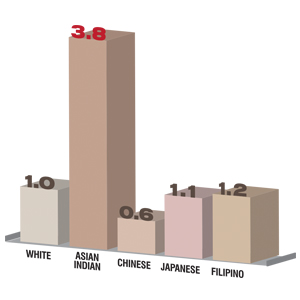The Great Indian Heart Paradox
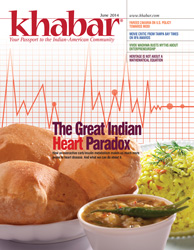
Despite smoking less, being leaner and mostly vegetarian, Indian immigrants are up to four times more prone to heart ailments compared to other demographic groups. Here’s an eye-opening explanation of why that is so, and what we can do about it.
Drop in at any Indian social gathering and almost inevitably the chatter will drift towards cholesterol numbers and the threat of oil, ghee, and sugar in our diets. We watch our calories and take pride in spreading butter substitutes on our toast hoping to stay healthy and lean. Statistically, we eat less meat, smoke less, and are leaner than the average Westerner. Shouldn’t we be a heart healthy community?
Strangely, no. The surprising news is that in spite
of these “healthy” parameters, studies1 from Canada,
U.S., and the United Kingdom have shown high rates of
heart disease among south Asian communities compared
to other immigrant populations. In the book Coronary
Artery Disease, the authors noted that:
“The CAD rates among overseas Asian Indians worldwide
are 50% to 400% higher than people of other ethnic origins
irrespective of gender, religion, or social class.”
Paradoxical, isn’t it? Here are some more alarming statistics:
|
|
|
Figure 1: Relative rates of hospitalizations for CAD in northern California for various ethnicities (courtesy of http://www. cadiresearch.org). |
• A northern California study on 13,000 participants
over a period of 7 years also found out that
Indians had the highest rates of hospitalizations
from coronary artery disease (CAD) compared to
other immigrant populations (Figure 1, above).
• The median age of first heart attack in Indians is
53 years, 10 years earlier than Westerners.
• The incidence of CAD in young Indians (under 50
years) is about 12% -16%, higher than any other
ethnic group.
• About 5% -10% of heart attacks occur in Indian
men and women younger than 40 years.
Two prominent factors, amongst other health and lifestyle considerations, could hold the answer to the puzzle of high incidence heart ailments and the relative young age of Indians succumbing to them: an overdriven carb/insulin metabolism and the stress of social dislocation.
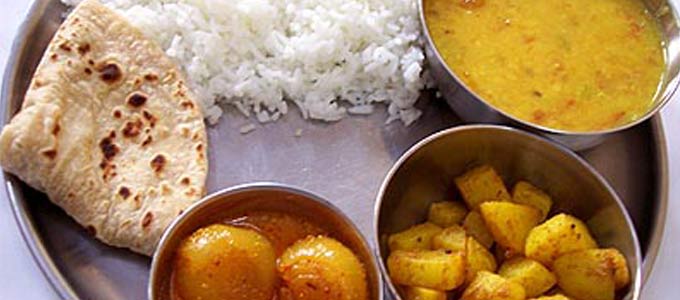
According to ChartsBin, a web based data-visualization service, Indians top the world in carbohydrate consumption, second only to the Republic of Congo. A whopping 71% of our calorie intake comes from carbs, with protein content at only 10% and fat at 19%.
Indians top the world in carbohydrate consumption
A typical Indian meal features chappati (or paratha)
along with rice, some vegetables (perhaps with potatoes)
and lentil or beans. Since a high percentage of
Indians are vegetarians, meat consumption is low. As
one may observe, the biggest calorie component in
our diet comes from carbohydrates—more specifically,
from easily digested carbohydrates found in wheat,
rice, and potatoes.
According to ChartsBin (http://chartsbin.com/view/1162), a web based data-visualization service, Indians top the world in carbohydrate consumption, second only to the Republic of Congo. A whopping 71% of our calorie intake comes from carbs, with protein content at only 10% and fat at 19% .
So how does a carb-rich diet impact our metabolism? Carbohydrates—long chains of sugar molecules whose prime purpose is to supply energy—break down into simple sugars in the gut, and are then absorbed in our blood. This causes a rise in the level of blood sugar. Excess blood sugar sticks to lipids and proteins to form Advanced Glycation End-products (AGE) that are responsible for systemic inflammation and oxidation in our bodies, leading to heart disease, Type II diabetes, osteoarthritis, age related dementia, and certain forms of cancer.
Excess sugar in blood is undesirable. To regulate its levels, our pancreas secretes insulin. Insulin plays the sugar cop by signaling the liver to convert the excess sugar into fat molecules—those tiny villains we know as triglycerides. These triglycerides are then transported to their final storage location inside fat cells. And that’s how we gain weight.
When blood sugar rises rapidly from a carb-rich meal, the pancreas overproduces insulin. After the excess sugar is stored away as fat, the leftover insulin keeps working to store the remaining blood sugar. This causes a sharp drop in your sugar level leaving you low on energy and craving another high-carb fix.
Over time, due to these insulin spikes and sugar crashes, the fat cells become resistant to insulin action, just as we become immune to traffic noise if we live by a highway. As a result, even more insulin is needed to do the same job. At this point, a person is said to have developed insulin resistance or metabolic syndrome: their insulin and sugar levels are simultaneously high.
Visceral fat—the fat surrounding your vital organs (liver, stomach, gall bladder, etc.) as opposed to subcutaneous fat that’s just beneath the skin—is exposed to a higher flow of blood and also has higher number of insulin receptors. Hence, any excess blood sugar is most likely stored in this area. Visceral fat is also a rich source of many inflammatory molecules that are transported directly into the liver for circulation around the body, contributing to systemic inflammation which is the cause of many of today’s lifestyle diseases.
Metabolic syndrome, when left untreated, leads to Type II diabetes, where the pancreas completely ceases to produce insulin.
The second distinctive cause, which is not specific to Indians only, that contributes to weight gain is eating pattern. Most people eat a light, quick breakfast before rushing to work, followed by a comparatively heavier lunch. Dinner being a family ritual is the day’s biggest meal, followed by dessert.
What makes Indians, again, more susceptible, is, generally speaking, dinner in an Indian home is eaten just an hour or two before going to bed when activity levels are winding down. So how does this eating pattern affect our metabolism?
At this point it helps to understand two concepts: Basal Metabolic Rate (BMR) and Activity Thermogenesis (AT). BMR is the minimum amount of energy required to sustain vital body functions. This is the energy you burn even when resting or sleeping, so it’s also called resting metabolic rate (RMR). The activity thermogenesis is the amount of energy you burn doing daily activities, everything from brushing your teeth to washing your hands to exercising. Your daily calorie expenditure is a combination of BMR and AT. While BMR stays more or less constant throughout the day, AT expenditure depends on what you are doing at any given time. For most people, AT is highest in the morning and tapers off by the end of the day.
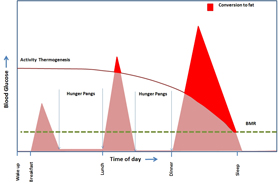
Figure 2. Blood glucose response to a typical eating pattern.
Figure 2 shows the relationship between daily eating patterns and the resulting blood sugar levels through a typical day. In the first ‘breakfast triangle’ the blood sugar spikes slightly but as it’s well below the AT expenditure, the excess sugar gets used up. The moderately larger ‘lunch triangle’ has a small red apex representing excess unused blood sugar beyond AT expenditure, which gets stored as fat. In the largest ‘dinner triangle’ the prominent red apex represents all excess blood sugar beyond the AT expenditure that is stored as fat.
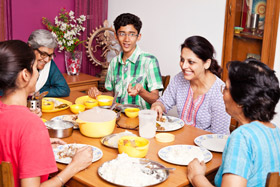
Indians are known to eat a late dinner, leaving very little time between it and sleeping time. Eating a big meal precisely when the body’s Activity Thermogenesis (see figure 2) takes a dip is a recipe for overdriving the carb/insulin metabolism that causes heart ailments.
From this triangle, it’s apparent that the later you eat dinner, the more the big triangle moves to the right pushing more of the area beyond the AT curve into fat storage zone.
Combine a high-carb diet and this eating pattern and you get fat gain leading to insulin resistance and eventually, metabolic syndrome.
The current Coronary Heart Disease (CHD) metrics
like total cholesterol, BMI, fat intake, etc., don’t capture
the true risk of developing heart disease. Medical
researchers are realizing that better predictors of
CHD risk are:
1) Triglyceride levels
2) Fasting glucose levels and
3) Waist to hip ratio (which captures visceral
obesity, as opposed to BMI).
These are the exact three metrics Indians fail, which makes us susceptible to CHD. And all three of them point to a single cause: an overdriven carb insulin metabolism. Add to this a lack of sufficient exercise, and is it any wonder that even young Indians are susceptible to heart ailments?
This brings us to the second aspect that predisposes immigrant Indians to heart disease—the stress of social dislocation!
Subliminal stress among immigrant communities
is a potential killer
The term “Stress kills” has actual physical significance.
However, the body copes reasonably well to
the garden variety daily stress of modern living—a
looming deadline, bill payments, taxes, negotiating
crazy traffic, and scrambling to compress ever more
activities into our
waking hours.
What proves more detrimental, particularly to immigrant communities, is the subliminal stress working at a deeper level of consciousness: the stress of social dislocation (being in a foreign land), cultural alienation, socioeconomic problems, depression, and anxiety are all examples of subliminal pressures that lead to chronic stress.
Like immigrant Indians, Japanese immigrants living in the U.S. have higher mortality from heart disease compared to those living in Japan. Traditionally, the Japanese were believed to have superior genetics with respect to heart disease (since Japan has the most number of centenarians alive) but this advantage seems to disappear when they start living abroad, even when they follow their traditional diets.
This phenomenon has been found to apply to immigrants worldwide. A 1990 study of Indian immigrants living in Singapore, compared to their Malay counterparts, found that, compared to the Malays, the immigrant Indians smoked less, had lower blood pressure and cholesterol, and yet their mortality was higher.
An Australian meta-analysis2 of 23 immigrant
population studies sought an answer to the very
vital question: is being an immigrant a heart disease
risk factor? The conclusion:
“Higher prevalence of cardiovascular disease was found
among Middle Eastern, South Asian, and some European
immigrants.”
In another remarkable study3 done in London, 364 participants were divided into two groups. One group comprised first generation immigrants living in London and the other group, their siblings living in Punjab. This eliminated any genetic/hereditary factors from corrupting the results. It was found that the London immigrants had higher BMI, blood pressure, and insulin resistance compared to their siblings in India, putting them at a higher risk of heart disease.
Stress impacts our health in a profound way. The human body reacts to stress by releasing two distinct hormones, adrenalin and cortisol. Adrenalin induces the primal ‘fight-or flight’ response in us during times of impending calamity. This raises the heart rate and blood pressure. The liver shoots out blood sugar to power the brain for a quick response. But this type of momentary stress doesn’t harm our long term health.
The other type of stress, which is what concerns us here, is the chronic and subliminal kind that cause the release of the second stress hormone, cortisol. Cortisol works very much like adrenalin but over longer time frames. In a normal healthy person the primary role of cortisol is to fine tune changes in the body that occur as a response to stress. Such changes include among others, blood sugar levels, blood pressure, and anti-inflammatory action. Cortisol levels peak a few hours after waking up and then again in the evening and stay low throughout most of the night. However, in a person with chronic stress, cortisol levels remain high all day leading to a range of health problems including high blood pressure, increased blood clotting factors, triglycerides, and insulin resistance. Specifically, cortisol increases blood sugar levels. However, since the excess sugar remains unutilized, it gets stored as abdominal fat, which medical research associates with heart disease and increased levels of ‘bad cholesterol’ (LDL).
Studies have shown that as cortisol levels rise so does the level of ghrelin, the hunger hormone, giving rise to hunger pangs. This causes the stressed individual to indulge in comfort eating. And as we all know, the best comfort foods for the brain are also high in sugar and fat.
Essentially, elevated levels of cortisol add to the harm caused by a carbohydrate rich diet—a double jeopardy for heart disease!
How to counter this vicious cycle?
Is there a way out of this double whammy to
which Indians are particularly susceptible? And can
it be done without resorting to the conventional
route of regulating cholesterol, hypertension, and
blood sugar through medication?
Yes, indeed. Adopting simple lifestyle and diet modifications can reduce our likelihood of getting heart disease. The two main goals in this health regimen are:
A) Insulin management through diet and lifestyle
Insulin management centers on the fact that
our blood sugar levels have to be regulated throughout
the day because that is what drives fat gain and
production of AGE free radicals. Clearly, the production
of this storage hormone has to be minimized.
Studies of centenarians across the globe have
shown that they come from diverse backgrounds and
lifestyles and some have even been regular smokers and alcohol drinkers. One distinctive common denominator, though, stands out among them—they have well regulated insulin levels, and as a result, they are rarely obese. The best way to regulate insulin levels is
by keeping our blood sugar levels low. This can be
accomplished by adopting a few diet changes:
1. Reduce the consumption of easily digested carbs from refined flours, rice, potatoes, and sweets. Instead get your carbs from whole grains, antioxidant and fiber rich vegetables, berries, nuts, seeds, lentils, etc. Fiber slows the absorption of sugar in blood, blunting the insulin spike; you stay satiated longer and don’t get ambushed by hunger pangs.
2. Nuts and seeds are also rich in monounsaturated fatty acids (MUFA), that bestow heart health benefits and could help reduce belly fat. Make sure the nuts you eat are in raw form as roasting or frying them at high temperatures renders the fatty acids toxic by forming free radicals.
3. Eat in accordance with your activity thermogenesis curve. Having a big breakfast, moderate lunch, and light dinner instead of the other way around is the best way to avoid insulin driven fat gain. Munch on snacks like almonds or a piece of fruit to keep hunger at bay. The saying “Eat breakfast like a king, lunch like a prince, and dinner like a pauper” goes a long way towards minimizing our likelihood for fat gain.
4. Get your nutrition from wholesome, organic produce at the local farmers market rather than depending on convenience dinners and processed foods from supermarket shelves that are loaded with harmful chemicals and genetically modified ingredients.
5. Increase your intake of healthy herbs and spices to fight oxidative damage. Many spices like turmeric, cloves, and cardamom, traditionally used in Indian cooking, are rich in antioxidants that help fight against oxidative damage and chronic inflammation that lead to heart disease. Antioxidants have also been shown to increase insulin sensitivity which helps with weight loss.
6. Daily mild to moderate paced walking. Walking has been shown to lower blood sugar for up to 24 hours after the activity.
7. Some form of weight bearing exercises (like pushups, body weight squats) 2-3 times a week. Weight bearing exercises build muscle which is the preferred storage reserve for excess blood sugar (as glycogen). Building muscle makes you more carb tolerant and helps regulate sugar and insulin levels, not to mention other health benefits like release of testosterone and growth hormone that helps prevent aging and osteoporosis.
B) Stress reduction:
Follow these simple tips to help you relax:
1. Practice breathing techniques (pranayama) to lower blood pressure and reduce cortisol levels.
2. Get 7-8 hours of restful sleep every night. Sleep rejuvenates the body and helps normal- ize cortisol levels.
3. Exercise and be active. Plenty of studies have shown the link between exercise and reduction in depression and anxiety. Exercise also releases endorphins or feel-good chemicals in the brain that induce a general sense of well-being. Don’t indulge in comfort eating in times of stress. Try to understand the root cause of your stress and eliminate or control it instead of burying yourself in comfort foods.
4. Change your attitude. A positive attitude goes a long way towards preventing stress hormones and heart disease. Watch a comedy movie once in a while and laugh as often as you can. Laughter seems to lower cortisol production and goes a long way towards protecting heart health (its true—laughter is the best medicine!)
Indians have a rich culinary heritage and wholesome lifestyle traditions. From potent herbs and spices to colorful lentils and vegetables, our food is a powerful source of disease-fighting antioxidants and health-promoting ingredients. Coming from the land of Yoga and Ayurveda, Indian communities worldwide should be examples of vibrant health. So it is indeed a paradox that, sadly, we stand out for our high rates of heart disease.
Reviving our historically healthful culinary traditions and adopting the simple lifestyle changes outlined above will bestow robust health upon our communities, and free us from the clutches of most modern ailments. It’s time we challenged the ‘Indian paradox’—dil se!
Yogesh Verma is a health and fitness blogger (www.inutrifit.com) and a nutrition expert specializing in Indian diet.
Citations:
1. Anand SS, Yusuf S, Vuksan V, Devanesen S, Teo KK, Montague PA, Kelemen L, Yi C, Lonn E, Gerstein H, Hegele RA, McQueen M., Differences in risk factors, atherosclerosis, and cardiovascular disease between ethnic groups in Canada: the Study of Health Assessment and Risk in Ethnic groups (SHARE). Lancet. 2000 Jul 22;356 (9226):279-84.
Srinivas R Gunukula., Cardiovascular Disease In Asian Indian Population., Southwest Cardiac Associates, The Heart Hospital Baylor Plano (tech presentation).
John C Chambers MRCP, Omar A Obeid PhD, Helga Refsum MD, Per Ueland MD, David Hackett FRCP, James Hooper MD, Rebecca M Turner MSC, Slmon G Thompson DSC, Dr Jaspal S Kooner., Plasma homocysteine concentrations and risk of coronary heart disease in UK Indian Asian and European men. Lancet. 2000 Feb 12;355 (9203):523-27.
2. Dassanayake J1, Dharmage SC, Gurrin L, Sundararajan V, Payne WR. Are immigrants at risk of heart disease in Australia? A systematic review. Aust Health Rev. 2009 Aug;33(3):479-91.
3. Bhatnagar D, Anand I, Durrington P, Patel D, Wander G, Mackness M, Creed F, Tomenson B, Chandrashekhar Y, Winterbotham M, Britt R, Keil J & Sutton G (1995). Coronary risk factors in people from the Indian subcontinent living in West London and their siblings in India. Lancet 1995; 345: 405–409.
Enjoyed reading Khabar magazine? Subscribe to Khabar and get a full digital copy of this Indian-American community magazine.
blog comments powered by Disqus




